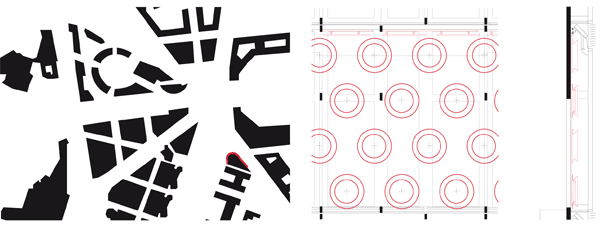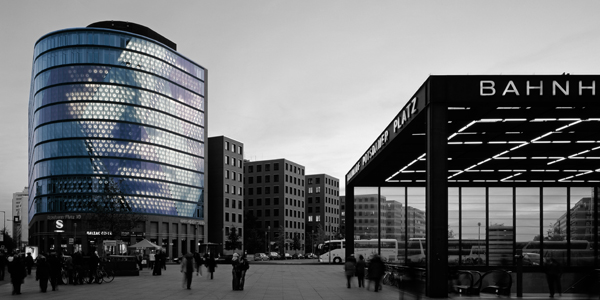
Subcutaneous Communication – Das Spiel mit dem leuchtenden Leerstand
SPOTS ist eine mediale Installation aus 1.800 Leuchtstoffröhren, die, individuell steuerbar und in einer Matrix angeordnet, die 11-stöckige Glasvorhangfassade eines Bürogebäudes am Potsdamer Platz in ein riesiges Display verwandeln.
Bespielt werden kann die Fassade mit beliebigen Grafiken, Bildern und Animationen, welche von geladenen Künstlern für den Ort geschaffen werden. Die Außenhaut des Gebäudes wird so zu einer kommunikativen Membran, welche das Gestaltungskonzept der Überlagerung von Loch- und Glasfassade aufgreift und durch eine weitere Mitteilungsebene thematisch fortsetzt.
Mit seinem groben Raster und der niedrigen Auflösung harmoniert die Bildschirmmatrix der fluoreszierenden Ringe mit der ästhetischen „Auflösung“ und dem Detaillierungsmaßstab seiner Umgebung. Auch in der Einfarbigkeit der Neonröhren setzt sich die Installation von den heute sehr weit verbreiteten, extrem hellen und bunten Bildschirmfassaden ab: SPOTS ist nicht auf Perfektion der Darstellung ausgerichtet, sondern stellt eine spezifische Ergänzung der Architektur und des urbanen Kontexts dar.
Damit ist die Fassade Objekt, Ort und Medium zugleich und es stellt sich eine Parallele zwischen der technischen Realisierung und den speziell entwickelten künstlerischen Bespielungskonzepten ein. Die diversen Formen der Überlagerung sind Ausgangspunkte für die Suche nach neuen Möglichkeiten, welche durch eine Synthese der unterschiedlichen Wirklichkeitsebenen das Wesen der Stadt materiell, bildlich oder ideell definieren.
Subcutaneous Communication – Vacant space in a new light
SPOTS is a light- and media installation hardware system comprising a light matrix of 1,800 industrial fluorescent lamps that is integrated into the 11 storey ventilated glass facade of an office building at Potsdamer Platz in Berlin.
As a result, designs, graphics and animation sequences choreographed by invited artists can be re-created on the façade as moving luminous images. Thus the external shell of the building is transformed into a communicative membrane. The design of the building's multi-layered skin (comprising a conventional solid facade punctuated by windows and a curtaintype glass façade) is thematically continued by the insertion of new communication layers.
With its large grid pattern and low resolution, the matrix of fluorescent rings harmonises with the aesthetic “resolution” of the architectural scale of the building and of Potsdamer Platz as a whole. In contrast to the rapid spread of urban media screens, the installation is not a neutral screen made for the perfection of the moving image but a specific extension of the architecture and the urban context.
SPOTS is simultaneously object, place and medium. A similarparallel is the relationship between the physical light installation and the customized artistic programme being screened on it. The various forms of superimposition that define this project point to a need for researching new ways to adapt or synthesize different realities that define the city's substantial, visual, and mental character.



